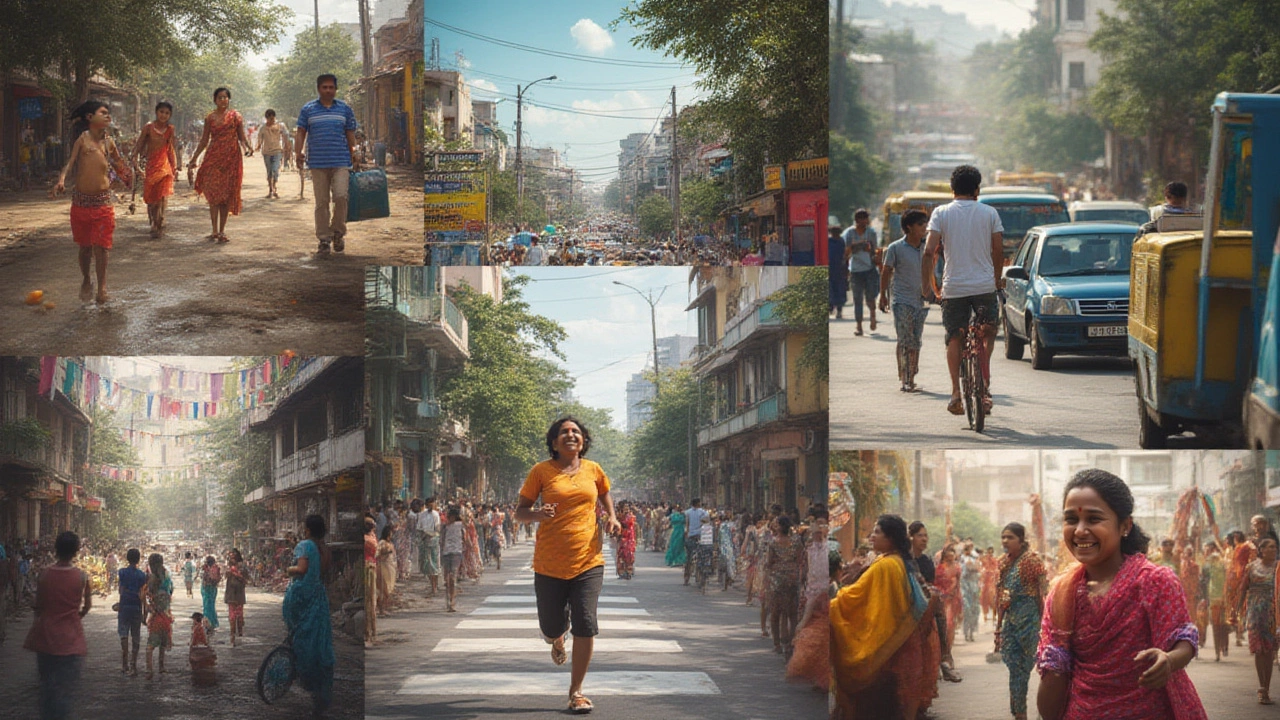Which Indian City Has the Best Quality of Life? Insights, Data, and Surprises
 Jul, 21 2025
Jul, 21 2025
Picture yourself sipping chai at a breezy café with no honking in the background, smog-free mornings, and streets that don’t turn into rivers during the first monsoon storm. Wishing for too much? Maybe. But if you've ever wondered which Indian city packs the best quality of life, you're not alone. The debate gets heated in every travel group, NRI WhatsApp chat, and expat hangout spot from Vancouver to Mumbai. Some swear by the cosmopolitan buzz of Bengaluru; others champion the green spaces in Pune or Hyderabad's food scene. But what does ‘quality of life’ even mean in the Indian context? Let's cut through the clichés and find out.
What Quality of Life Really Means for Indian Cities
The phrase 'quality of life' gets tossed around a lot, but in India, it stretches beyond air-conditioned malls and yoga parks. For starters, it’s about how safe you feel at night if you’re walking down the street with your phone out. It’s about the time you spend in traffic, the price of a half-decent flat, and whether you can get a quick filter coffee near your office. It’s also about pollution, water supply, healthcare, education, job prospects, and—perhaps most underrated—the city’s sense of community.
Multiple organizations try to rank Indian cities on livability using different yardsticks. The ministry of housing and urban affairs releases their "Ease of Living Index" every two years, with the 2023 list putting Bengaluru, Pune, Ahmedabad, Chennai, Surat, Navi Mumbai, and Coimbatore near the top. Mercer’s Quality of Living report goes with Hyderabad, followed by Pune. Real estate company PropTiger swears by Pune and Bengaluru’s rental yields as a sign of a rising middle class. But these lists don’t always agree, so let’s zoom into what makes these cities tick on the ground—not just on paper.
Let’s look at some of the focuses for quality of life:
- Cost of Living: Rent, groceries, utilities, and a Friday-night dinner out for two.
- Infrastructure: Roads, public transport (metros, buses, cabs), reliable internet.
- Work-Life Balance: Commute times, working culture, job opportunities.
- Air and Water Quality: Not just for kids or older folks—anyone who’s ever coughed walking down Delhi’s Outer Ring Road knows.
- Safety: Women’s safety, night life, general peace of mind.
- Recreation and Culture: Parks, restaurants, concerts, theaters, sports complexes.
- Healthcare and Education: Does the closest hospital actually have beds? Will your kid’s school send you a WhatsApp before closing for rain?
People who have lived in several Indian cities say that these priorities shift with your age, bank balance, and whether you're raising a family. For a young, single techie, Bengaluru and Hyderabad are magnets. For retirees, Mysuru and Pune are popular for their calm and greenery. So, let’s pull back the curtain city by city.
Pune vs. Bengaluru vs. Hyderabad – Head-to-Head
Pune consistently ranks high for both professionals and families. The weather is mild almost year-round, with cool evenings even in May (no kidding). Green spaces, wide roads, and a population that's known for politeness make Pune feel less like a megacity and more like a big small town. Young IT workers, students, and retirees all call it home. The city’s colleges bring a steady wave of cultural festivals, and if you’re a food lover, Koregaon Park serves everything from vada pav to vegan sushi. Sure, rental prices have climbed, but compared to Mumbai, you’re still getting value. Plus, Osho International Meditation Resort makes outsiders pilgrimage here for inner peace and fresh carrot juice.
Bengaluru (or Bangalore) is the “Silicon Valley of India.” If you’re in tech, startups, or gaming, the vibe here is addictive. There’s a joke that in Bengaluru, you’ll find three things at every corner: a pub, a biryani place, and someone launching an app. The city’s traffic is legendarily bad—peak hour is basically all day—but the metro network is growing. Walk through Indiranagar or Koramangala, and you’ll see dog parks, yoga cafes, brewing co-ops, and high-rise apartments with serious FOMO potential for friends elsewhere. Bengaluru’s weather is the gold standard. It never really gets too hot or freezing, and there’s breeze in the evenings that lifts your mood regardless of the eight meetings you sat through. Downsides? Some areas still have garbage woes, and water shortages are a yearly nightmare.
Hyderabad, which locals lovingly call the "City of Pearls," stands out for its old-meets-new charm. The historic Charminar rubs shoulders—at least in spirit—with the office parks of HITEC City. Costs are lower than Pune and Bengaluru. Modern skyways make western Hyderabad easy to navigate, and the city’s affordable rents mean you can actually have a balcony garden. Hyderabad was named the top Indian city for quality of living by Mercer for five years running. Ask around, and you’ll hear that Hyderabad’s true strength is community: neighbors mix across backgrounds, there’s little ‘big city’ arrogance, and the biryani at Paradise still blows people’s minds. If the thought of spicy breakfasts excites you, this is your place. The catch? Summers can be brutal.
What about Delhi, Mumbai, or Chennai? Each has a strong following, but also big downsides. Mumbai’s rents are famous for shrinking your dreams, while Delhi’s air quality makes international headlines every Diwali. Chennai offers great universities and affordable living, but humidity and language barriers (for the uninitiated) might narrow its appeal.
Here’s a snapshot of monthly living costs (in INR, for a family of four, 2024 estimates):
| City | Average Rent (2BHK) | Utilities | Groceries | Dining Out |
|---|---|---|---|---|
| Pune | ₹24,000 | ₹3,500 | ₹12,000 | ₹5,000 |
| Bengaluru | ₹30,000 | ₹3,800 | ₹13,500 | ₹6,500 |
| Hyderabad | ₹18,000 | ₹3,200 | ₹11,000 | ₹4,000 |
| Mumbai | ₹45,000 | ₹4,500 | ₹15,000 | ₹8,000 |
| Delhi | ₹33,000 | ₹4,000 | ₹13,000 | ₹7,000 |
Take those with a pinch of salt—neighborhood and lifestyle matter a lot. But if you’re after bang for buck, Hyderabad and Pune come out in front, while Mumbai is a wallet-buster.

The Data You Didn’t Expect: Nature, Safety, and ‘Vibe’
If you think quality of life is just about savings and efficient metros, you’re missing half the picture. More people are picking cities based on how close they are to nature, the quality of friendships made as adults, and their 'vibe'—the stuff that doesn’t fit on a spreadsheet.
Bengaluru has the highest concentration of public parks in any Indian city. Cubbon Park alone is a massive green lung, and weekenders zip out to Nandi Hills or Coorg for fresh air. Pune sits near the Western Ghats—Lonavala and Mahabaleshwar are just a drive away, so you don’t need to book flights for quick getaways.
Hyderabad does well on safety stats, especially for women, compared to other metros. It’s also a rare big city where you’ll see mixed communities living next to one another (Mehdipatnam, Banjara Hills, Jubilee Hills), which helps keep street culture welcoming.
But what about air pollution? Here’s a recent Air Quality Index (AQI) snapshot for 2024 averages:
| City | Yearly Avg. AQI |
|---|---|
| Pune | 58 (Moderate) |
| Bengaluru | 52 (Moderate) |
| Hyderabad | 70 (Moderate, slips into unhealthy in summer) |
| Mumbai | 84 (Unhealthy at times) |
| Delhi | 152 (Always Unhealthy) |
You might not notice those numbers every day, but if you jog or have kids, they matter. Pune and Bengaluru have edge here—Delhi’s infamous smog puts it out of the running for now.
Want to talk education? Both Pune and Bengaluru are dubbed “student cities,” with dozens of institutions like the Symbiosis and Fergusson in Pune, and IISc and Christ University in Bengaluru. Hyderabad’s Osmania University and Indian School of Business are big draws, too.
One surprising trend post-pandemic: More Indians are chasing balance over just a fat paycheck. Flexible work has opened up options to live in smaller, less crowded spots. Places like Mysuru, Chandigarh, and even Coimbatore are pulling in folks looking for cleaner air and friendlier streets—but they lag when it comes to nightlife, global cuisine, and sheer opportunities.
If ‘vibe’ is your thing, here’s what locals say:
- Pune: “Feels like college never ended—the city is young.”
- Bengaluru: “Chill, where every third person has a podcast.”
- Hyderabad: “Community first. We eat together and celebrate every festival.”
Tips for Picking the Right Indian City for You
So, which Indian city tops the list for best Indian city by quality of life? There’s no single winner—you’ll get different answers depending on what matters to you. But you can narrow your personal choice by following these tips:
- If you’re in tech or startups and want a friendly international crowd, Bengaluru is tough to beat. But brace for traffic—get a place close to your office, or pick a coworking space walking distance from home.
- If you value community, low rent, and great food, Hyderabad is your jam. Pick a spot near HITEC City or Banjara/Jubilee Hills for the best blend of modern and historic.
- Pune suits families, students, and those who hate Delhi/Mumbai-level chaos. If you work remote, you’ll find fast internet and plenty of outdoorsy spots for quick resets. Stay in Aundh or Baner for a blend of city life and calm. Avoid the old city if you don’t like congestion.
- If you love the sea and don’t mind high rents, Mumbai has unbeatable energy. Just set expectations for apartment sizes low.
- Chennai, Kochi, Coimbatore, Chandigarh—great for regional flavor, calm, and lower living costs, but might lack that international buzz or career jump others offer.
Here are some quick-fire tips to smoothen your move:
- Always visit your shortlisted city (or at least stay a week in an Airbnb). The feel changes neighborhood by neighborhood.
- Chat with locals, not just realtors. Find out which areas get water/traffic/garbage issues in summer or monsoon.
- Check if your office offers hybrid work or a relocation subsidy. Some companies pay for petrol or even flexible memberships at gyms and cafés.
- Look up air quality and commute times before picking your area. Google Maps data is pretty spot-on for Indian cities now—use it like a local.
- If you have pets or kids, check for proximity to parks and schools. Some neighborhoods in Bengaluru have off-leash dog parks and Montessori schools right down the street.
One last thing—don’t get caught up in rankings alone: Focus on whether you can build your routine easily, find friends, and honestly, breathe clean air. Cities change fast, but what matters at the end of every day is if you’re happy to call your spot “home.” After years on two continents (and a lot of late-night research), I’d put Pune and Bengaluru slightly ahead, with Hyderabad close behind. But hey, sometimes the best city for you is the one you give a shot.